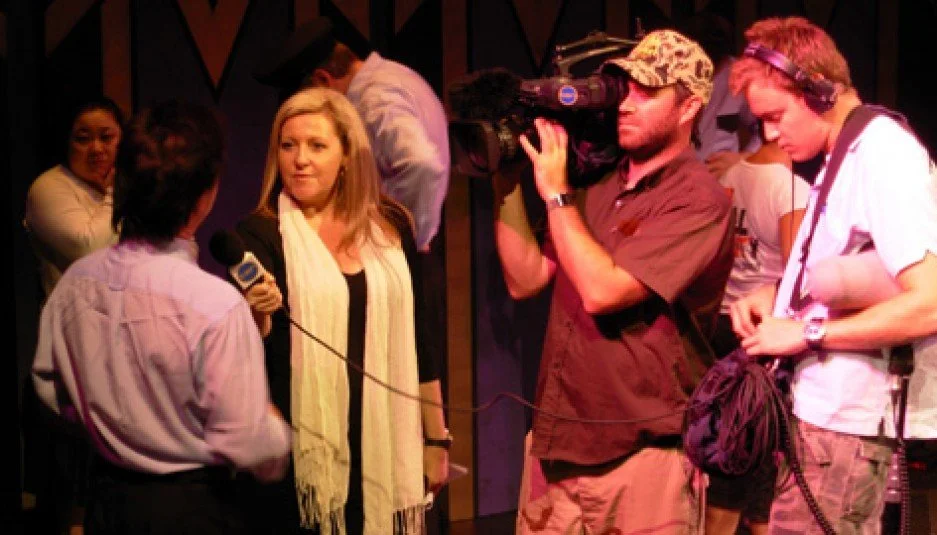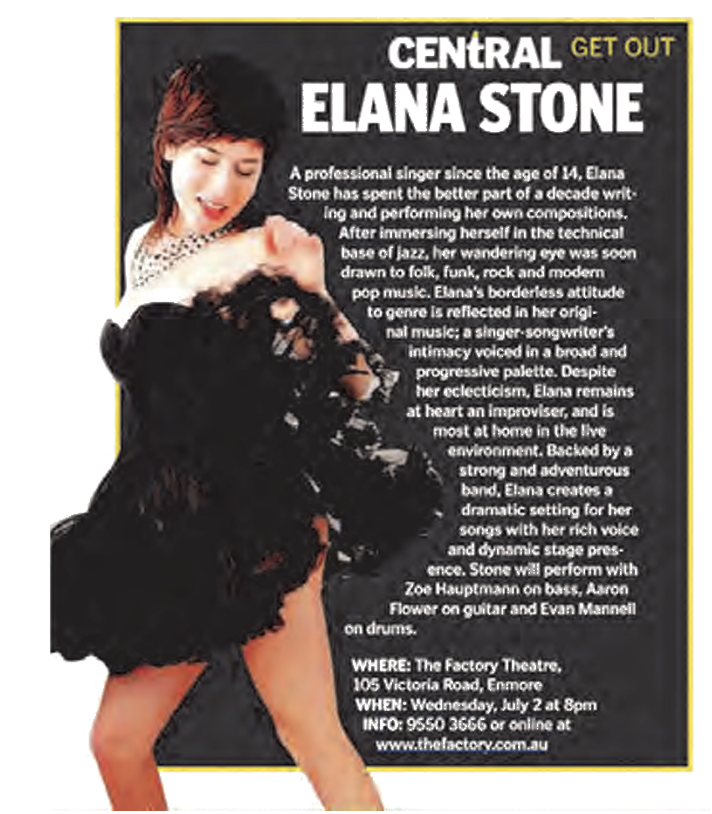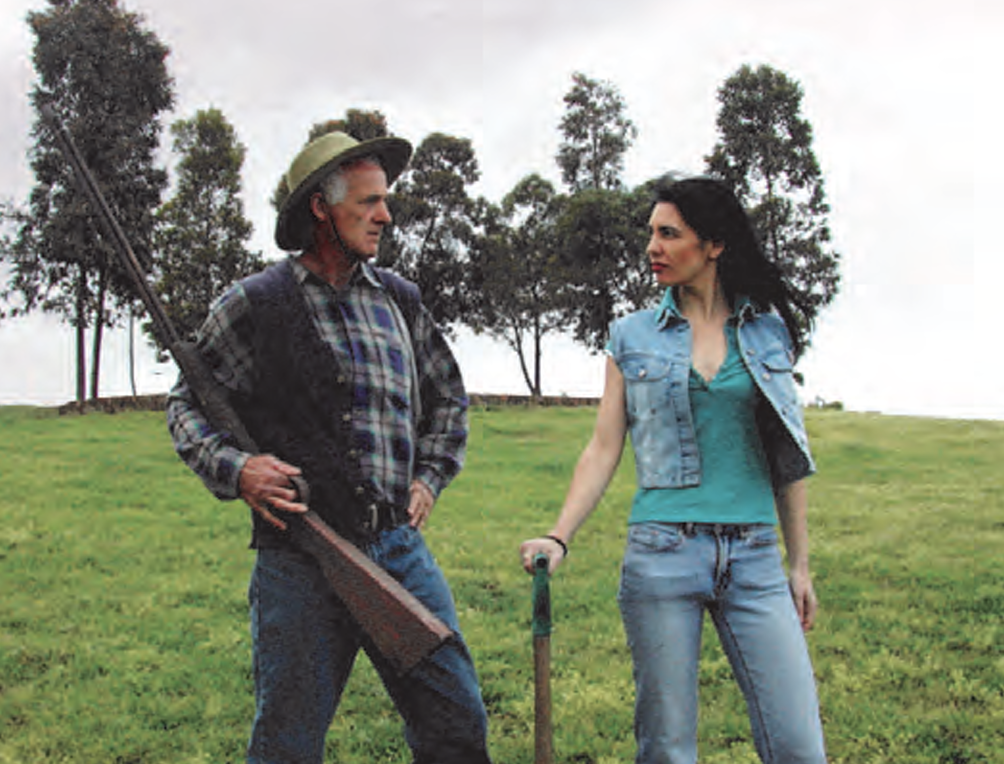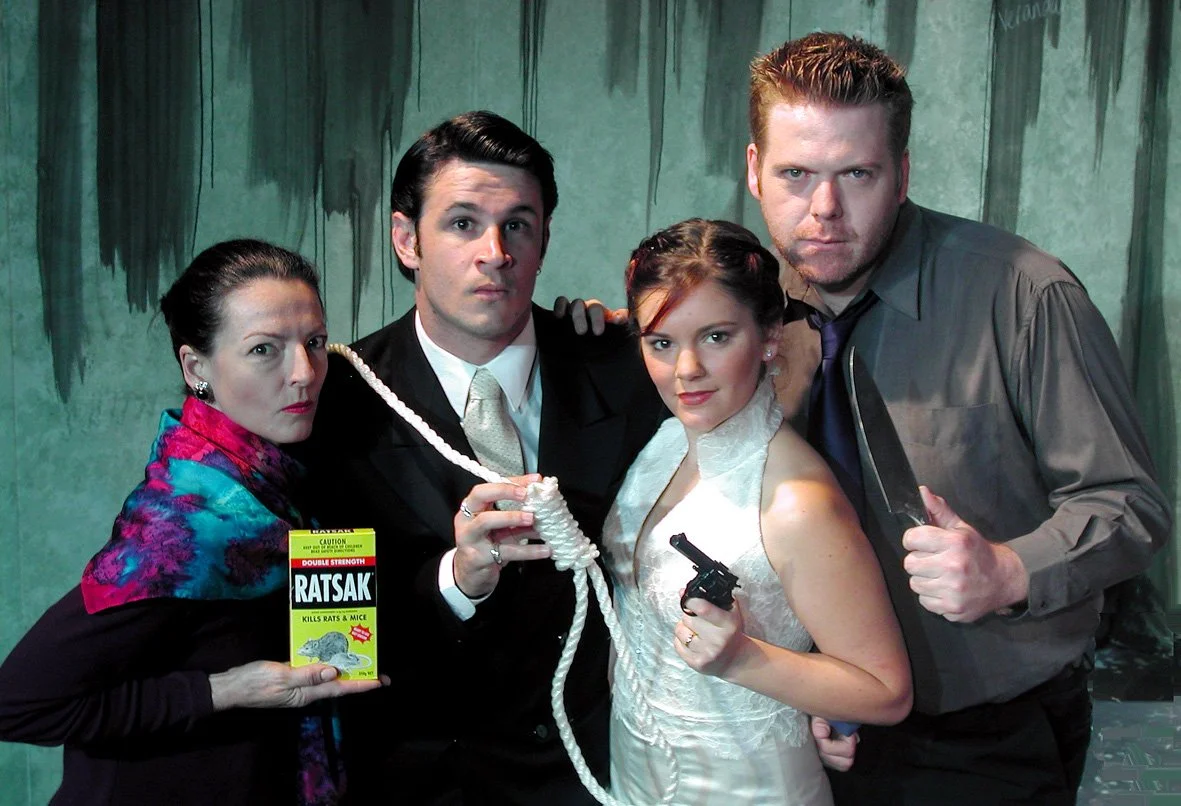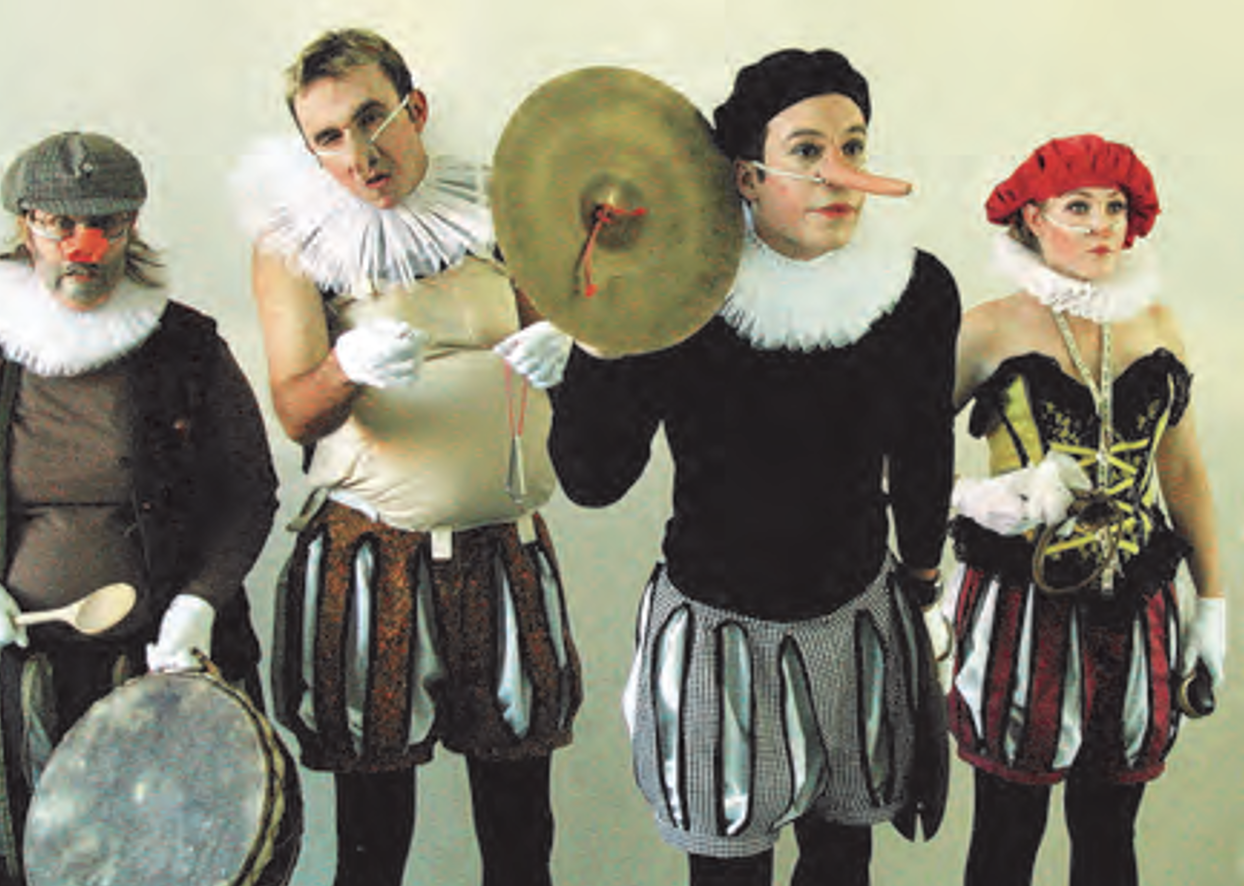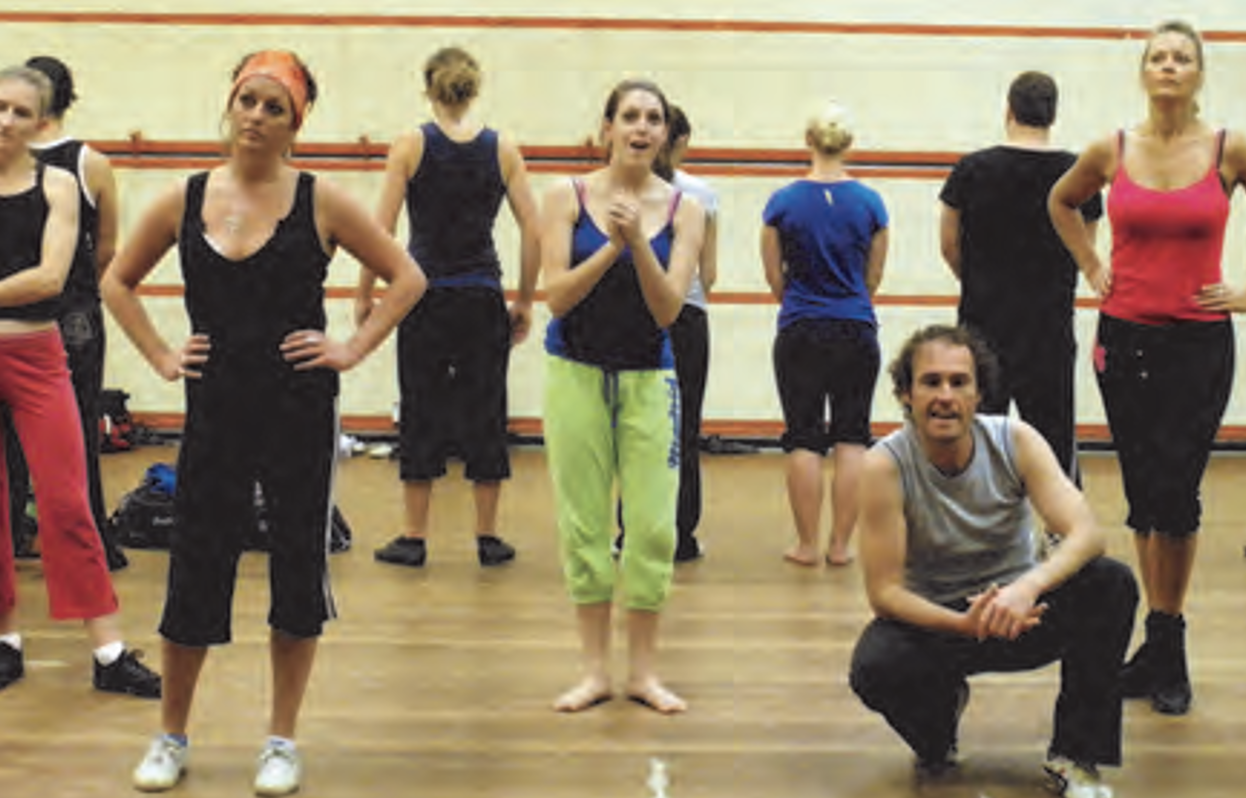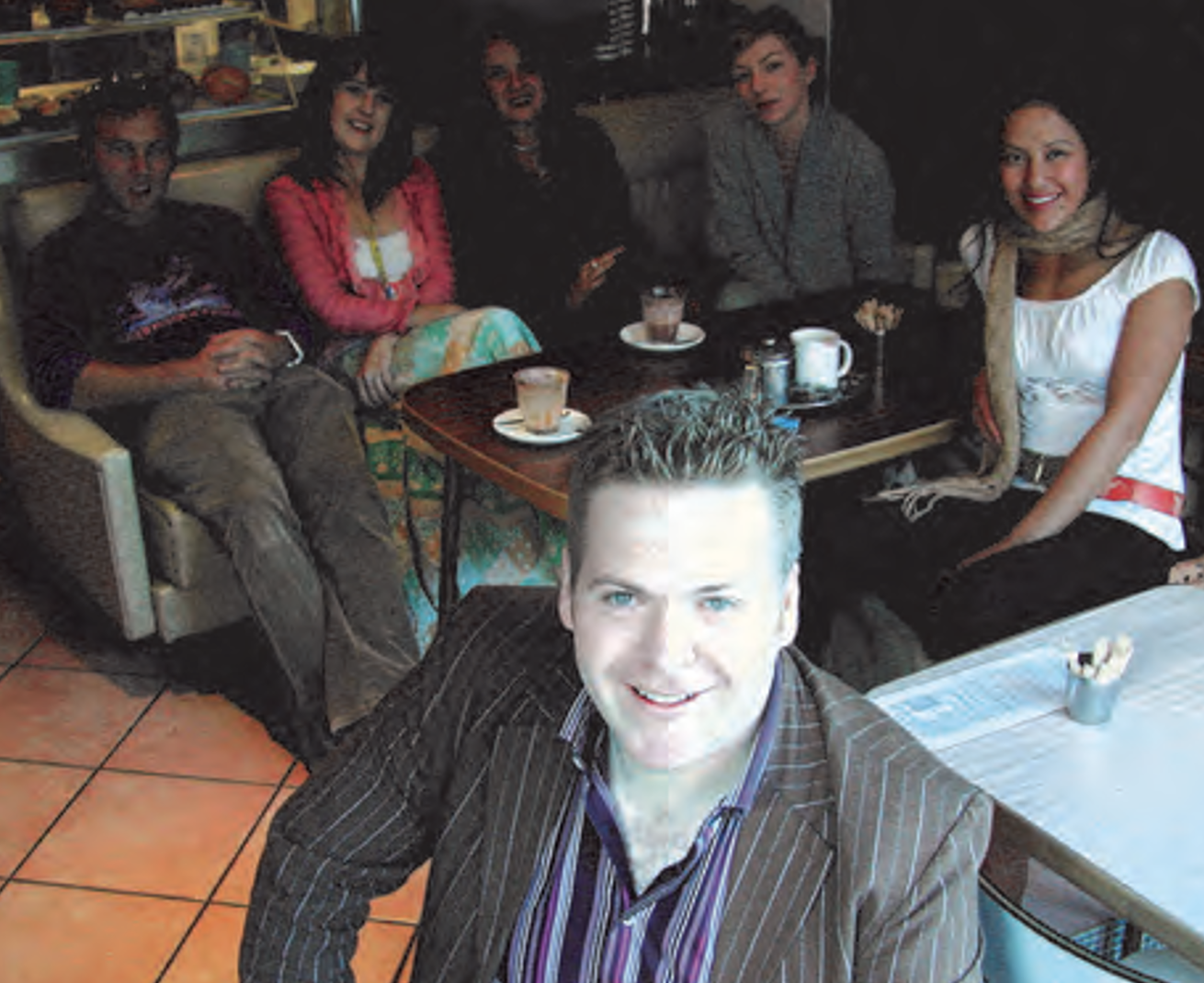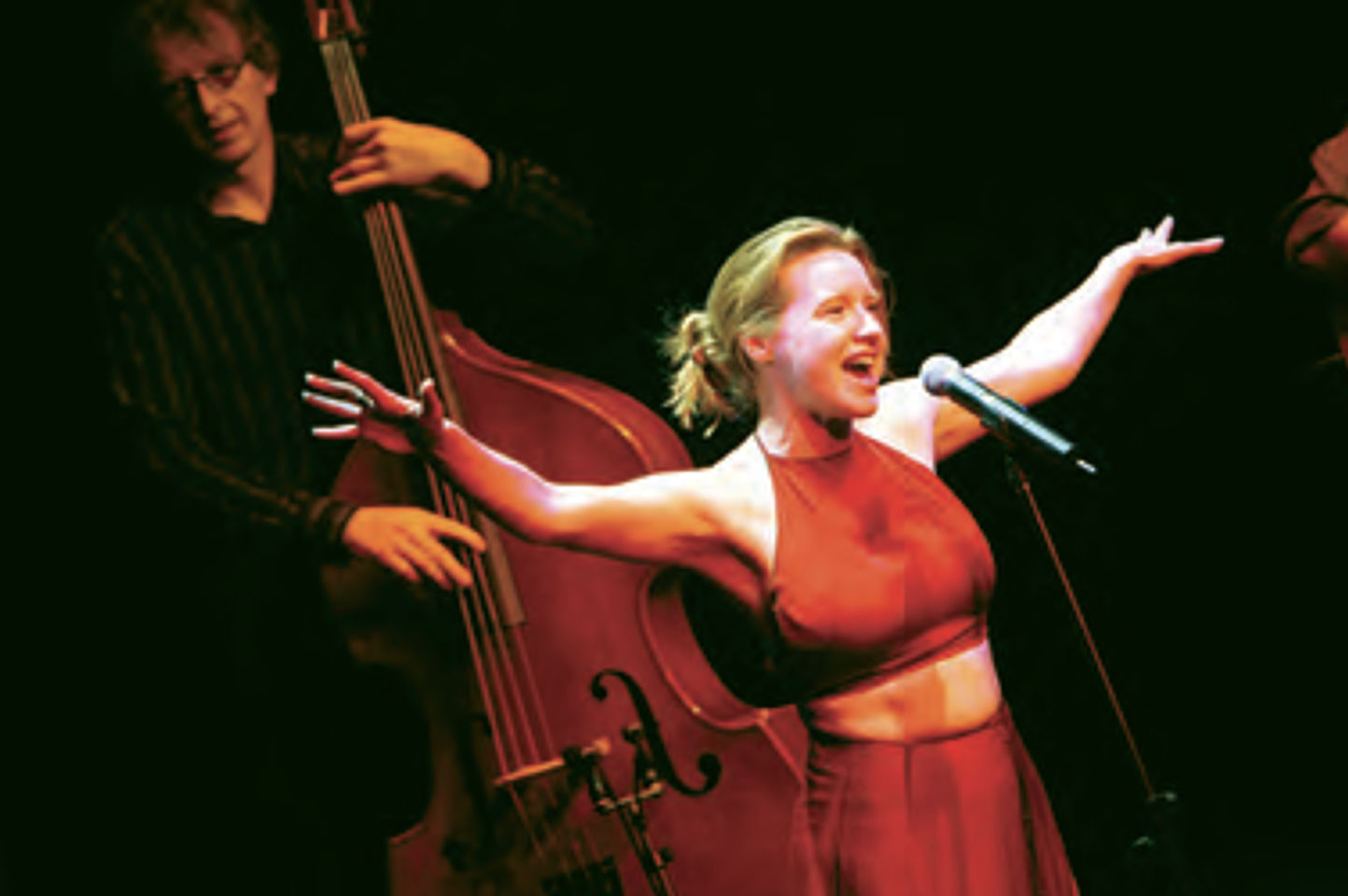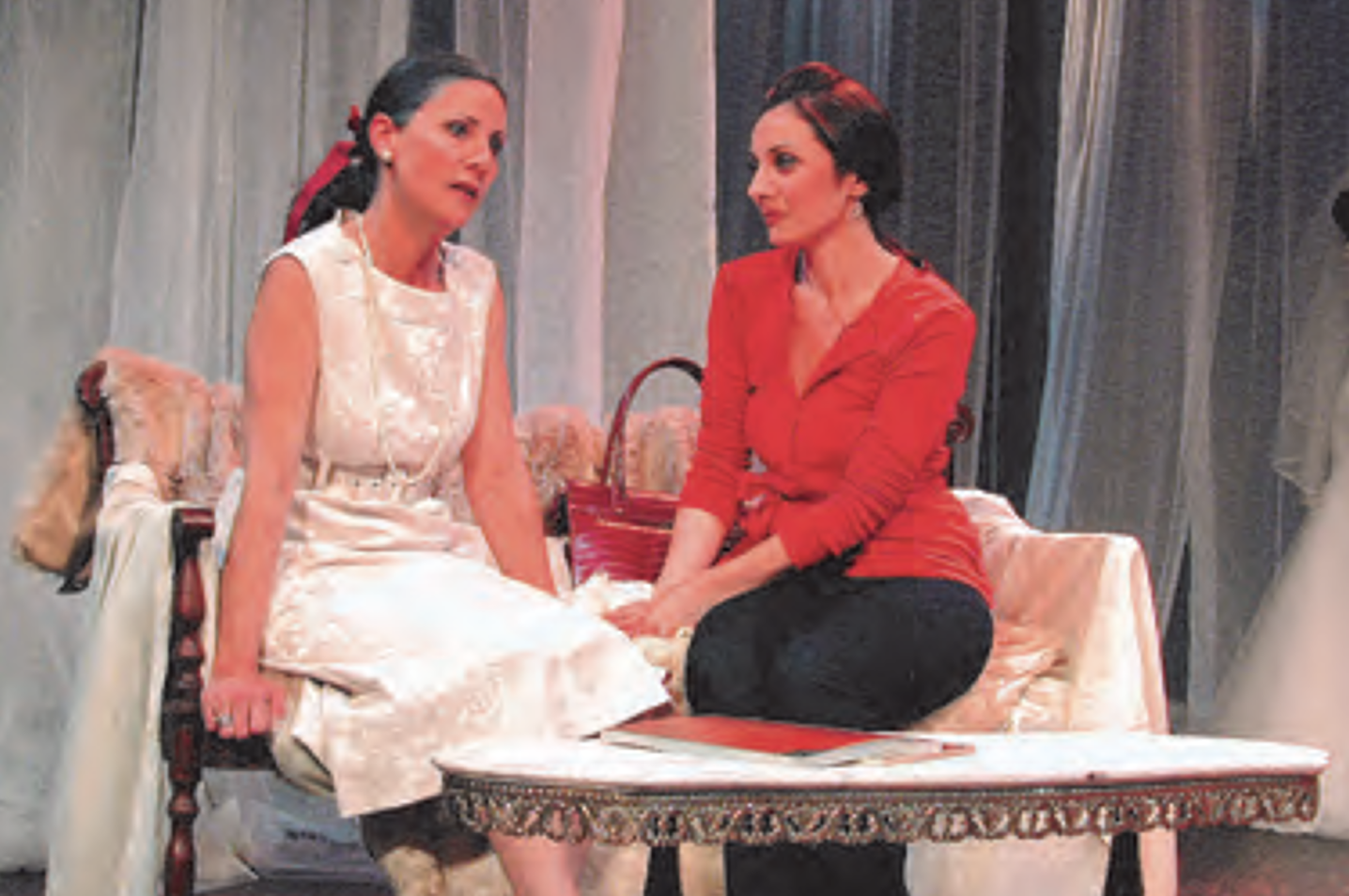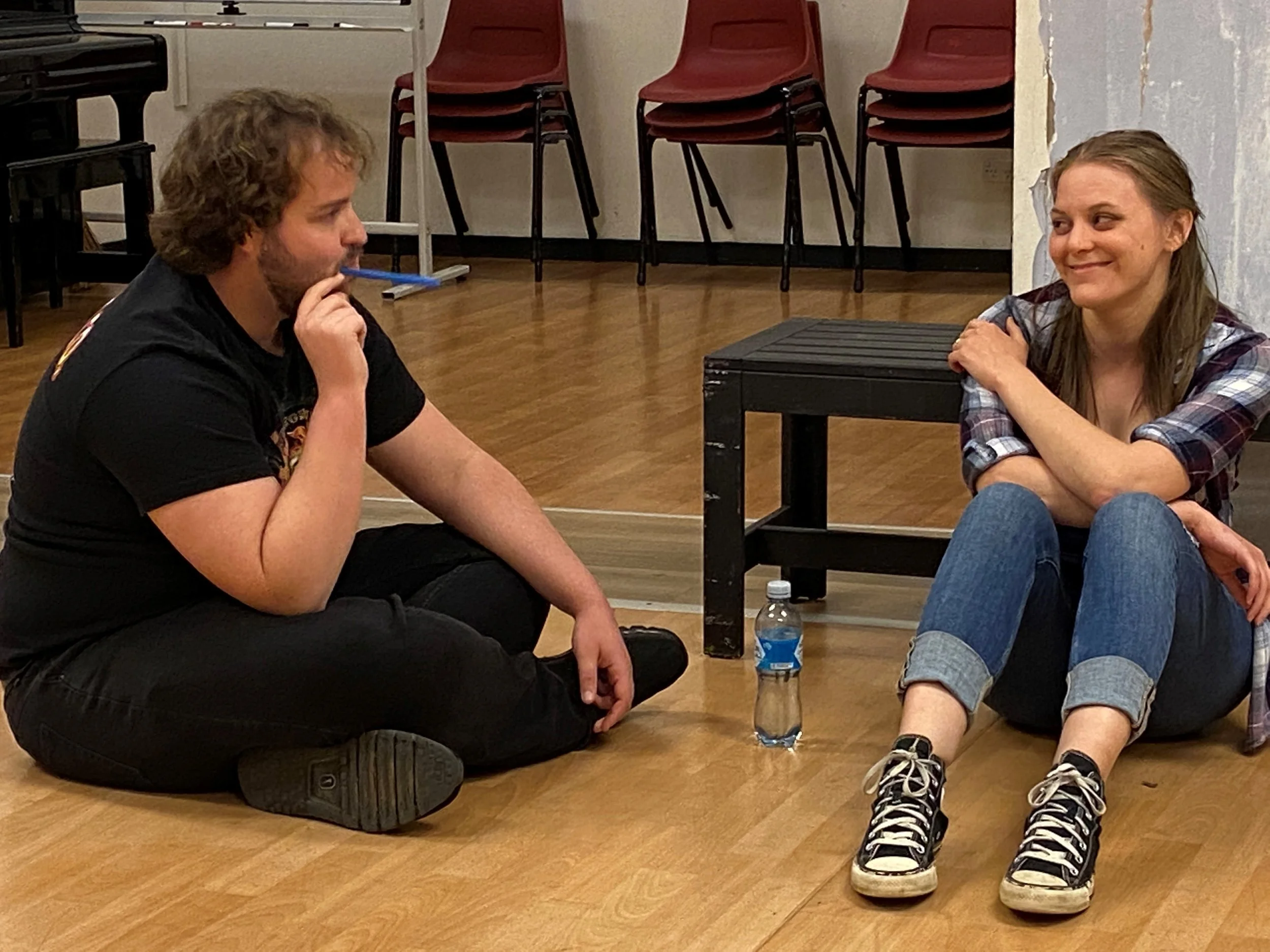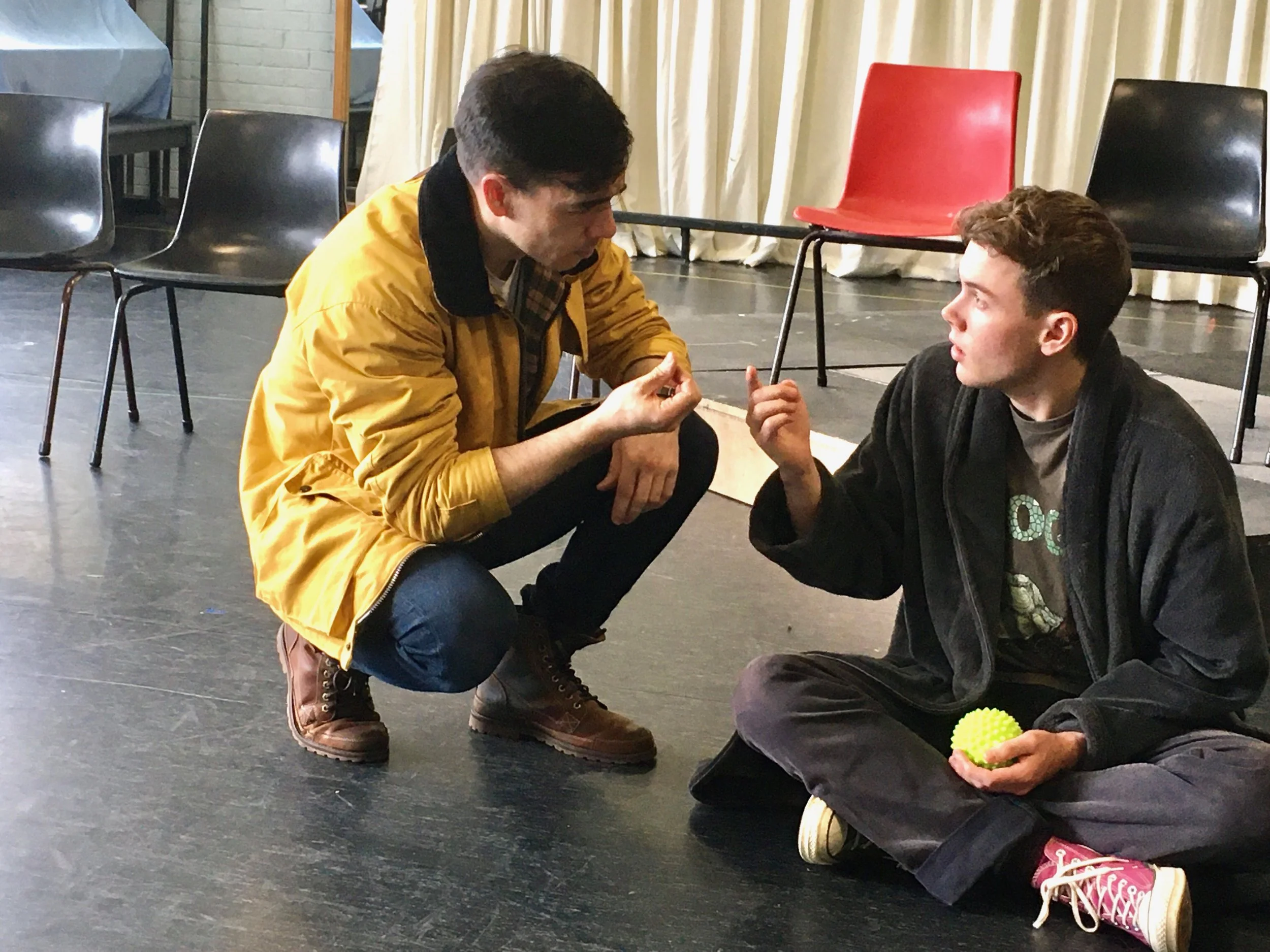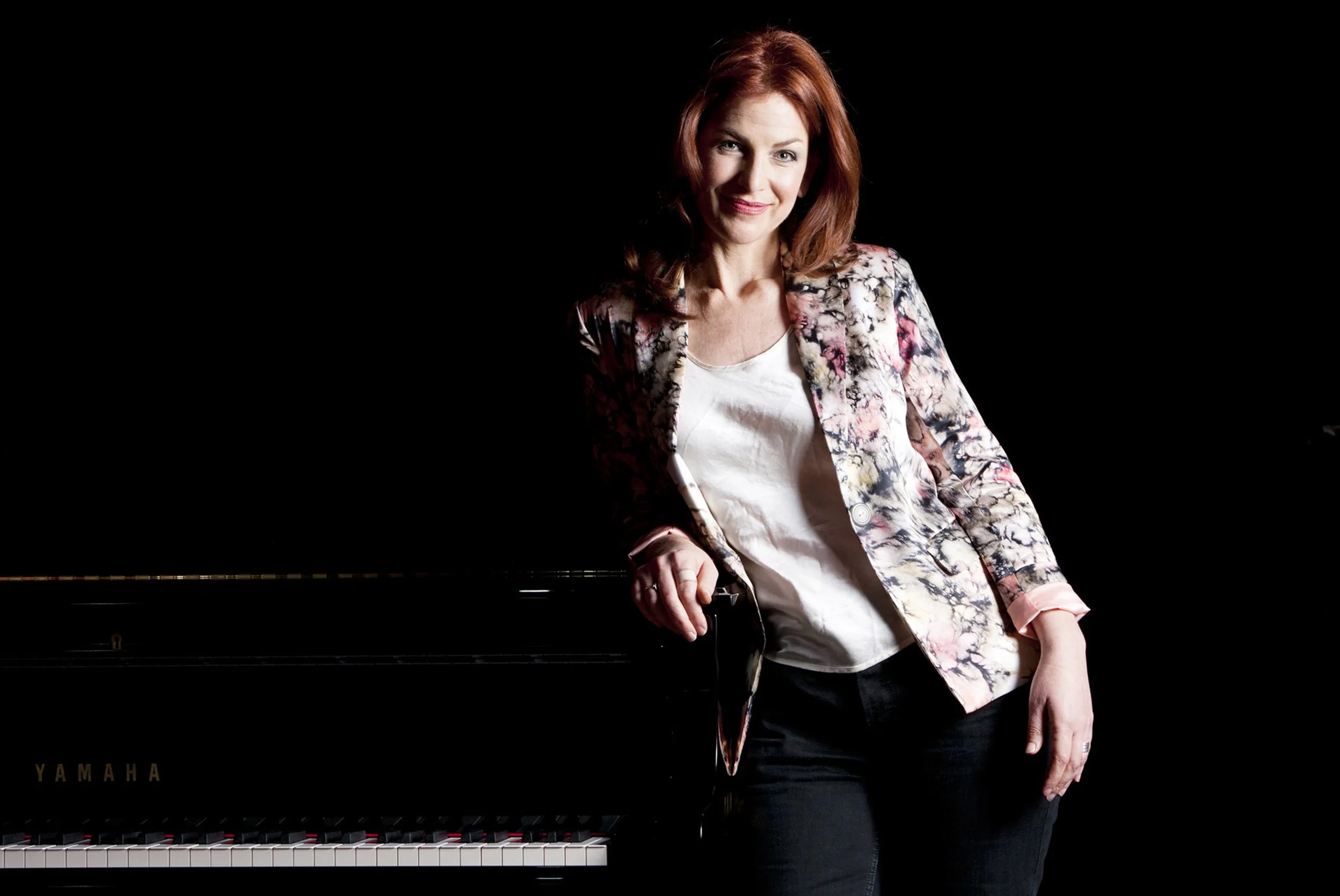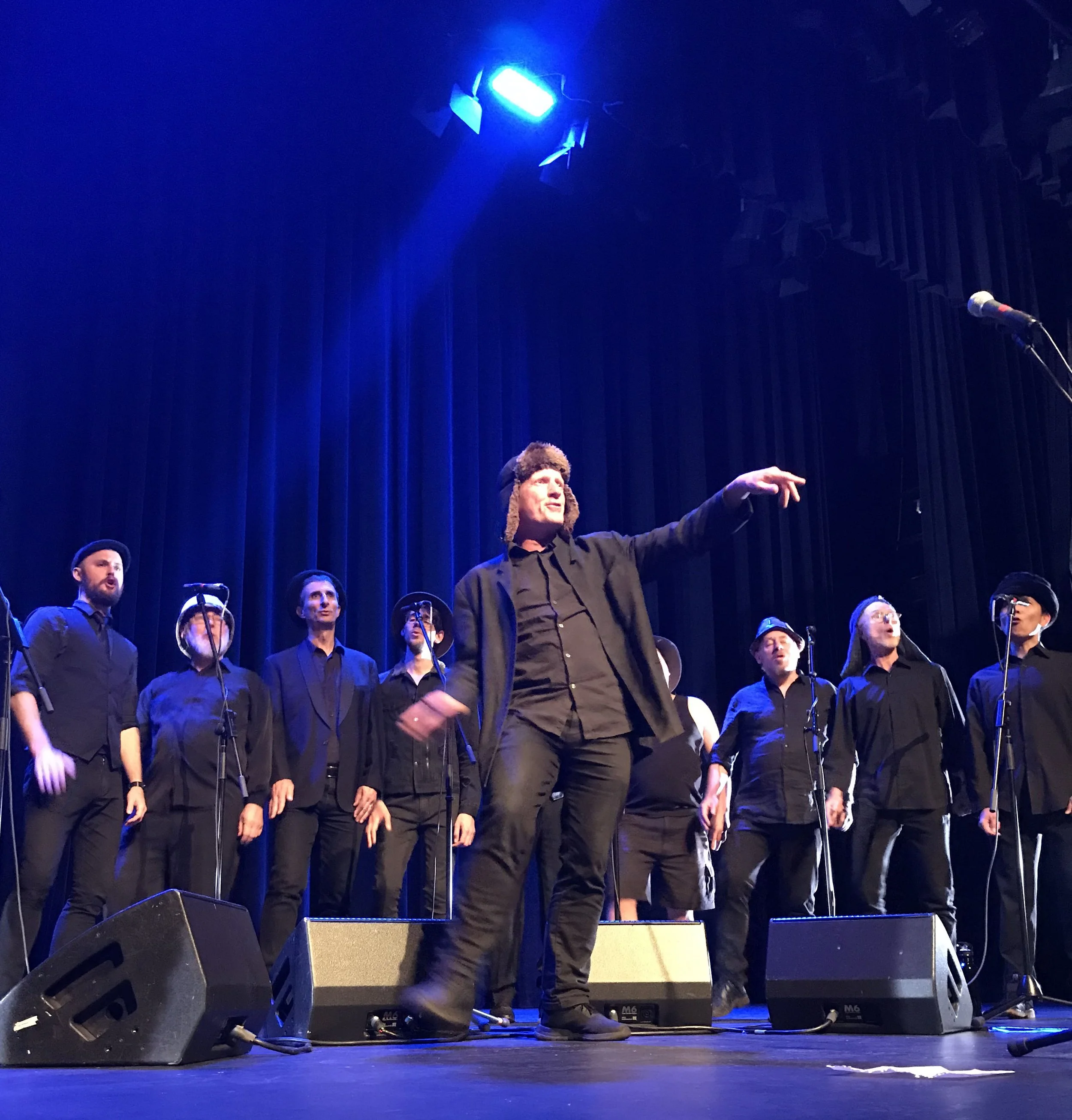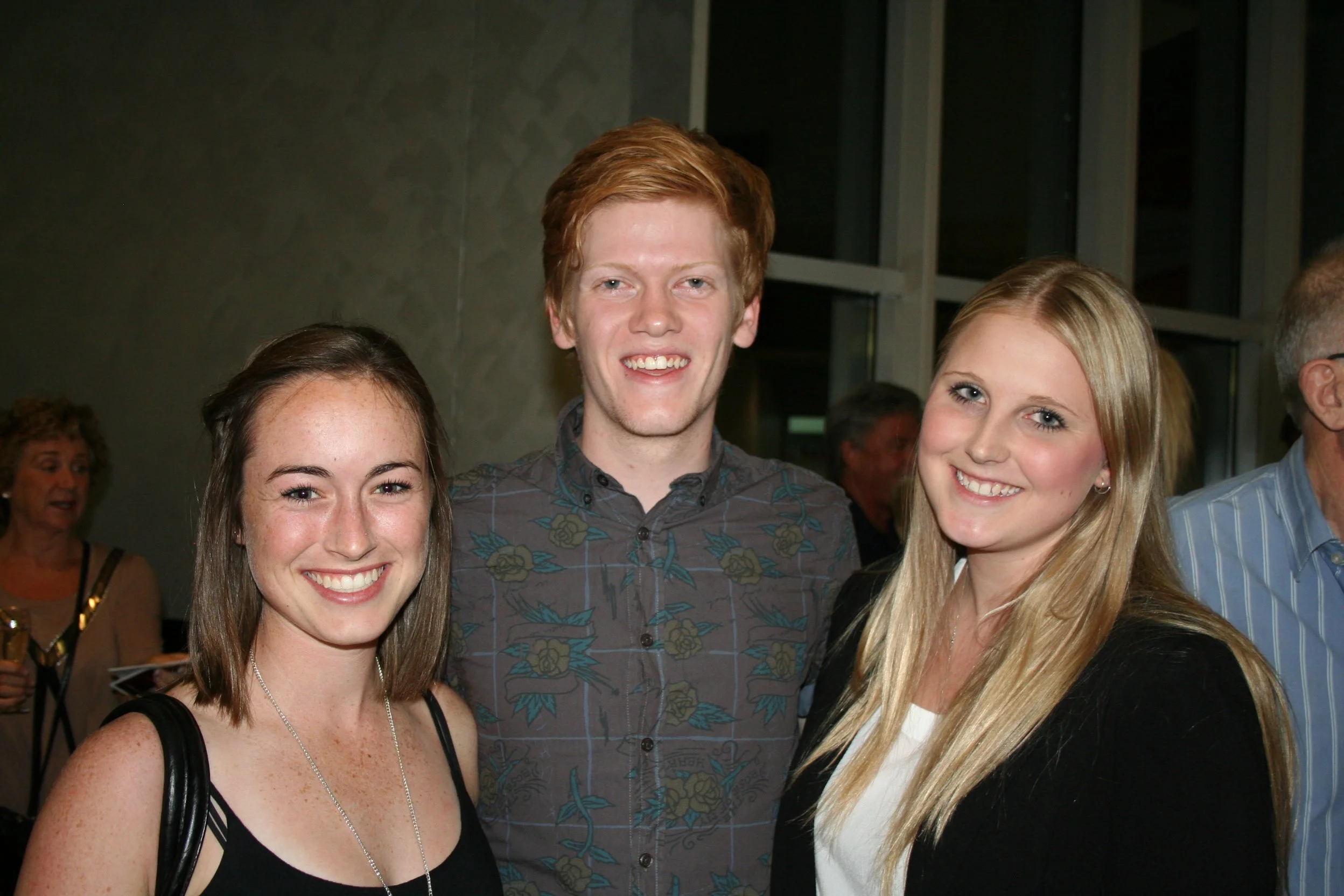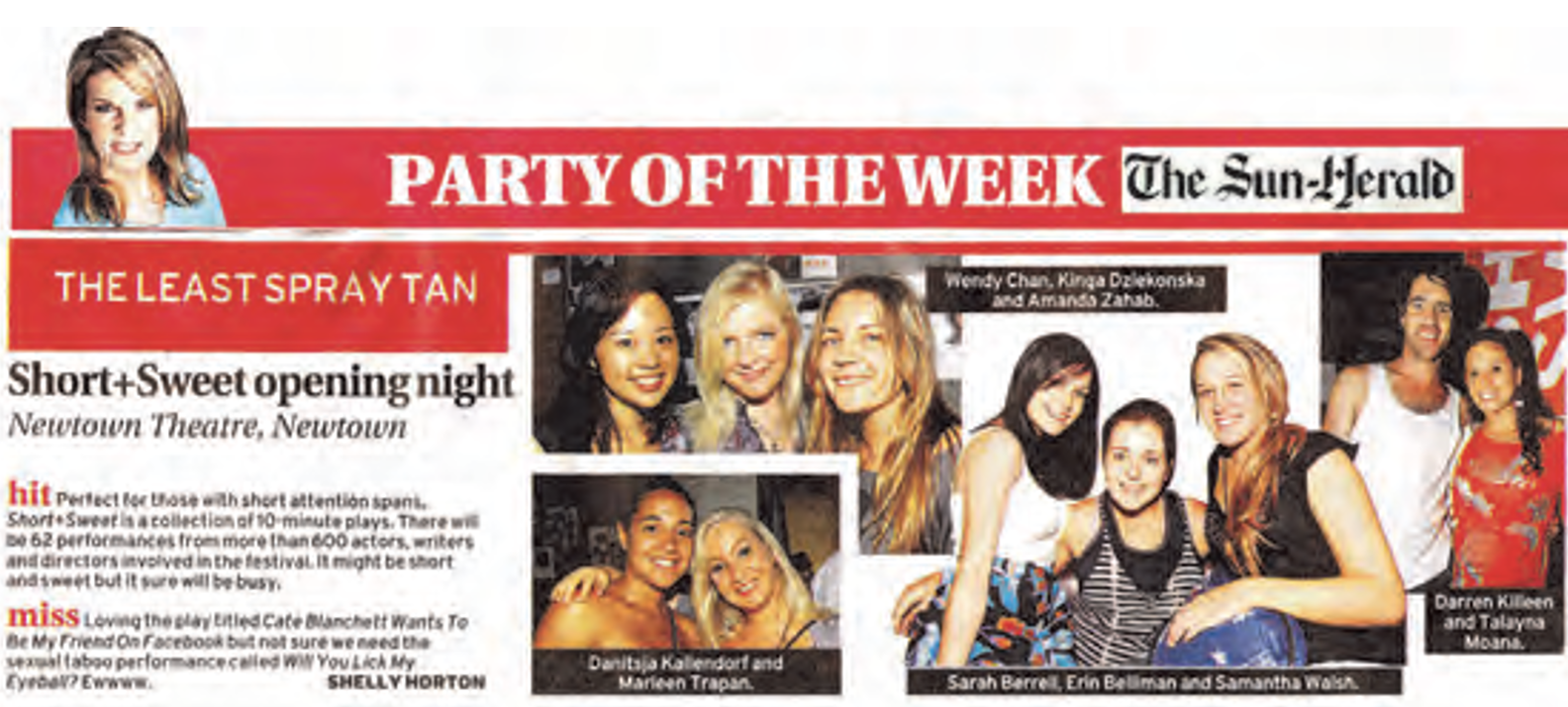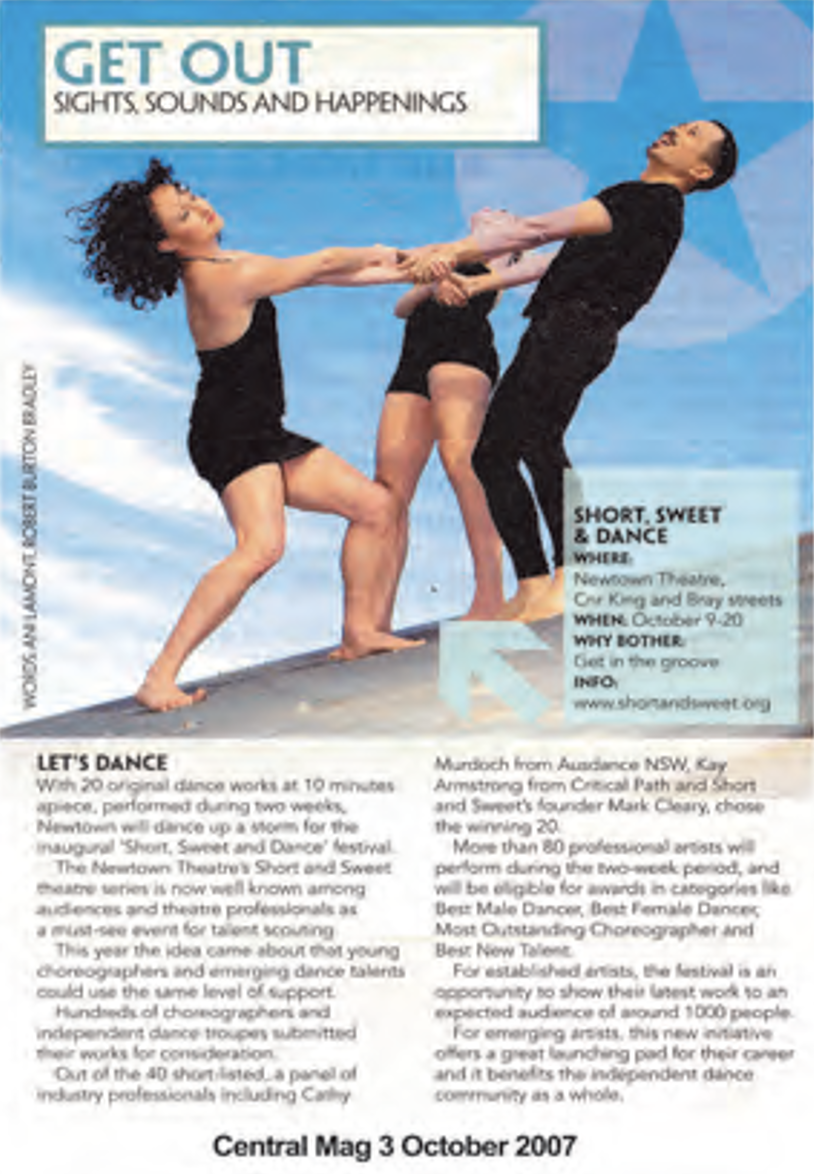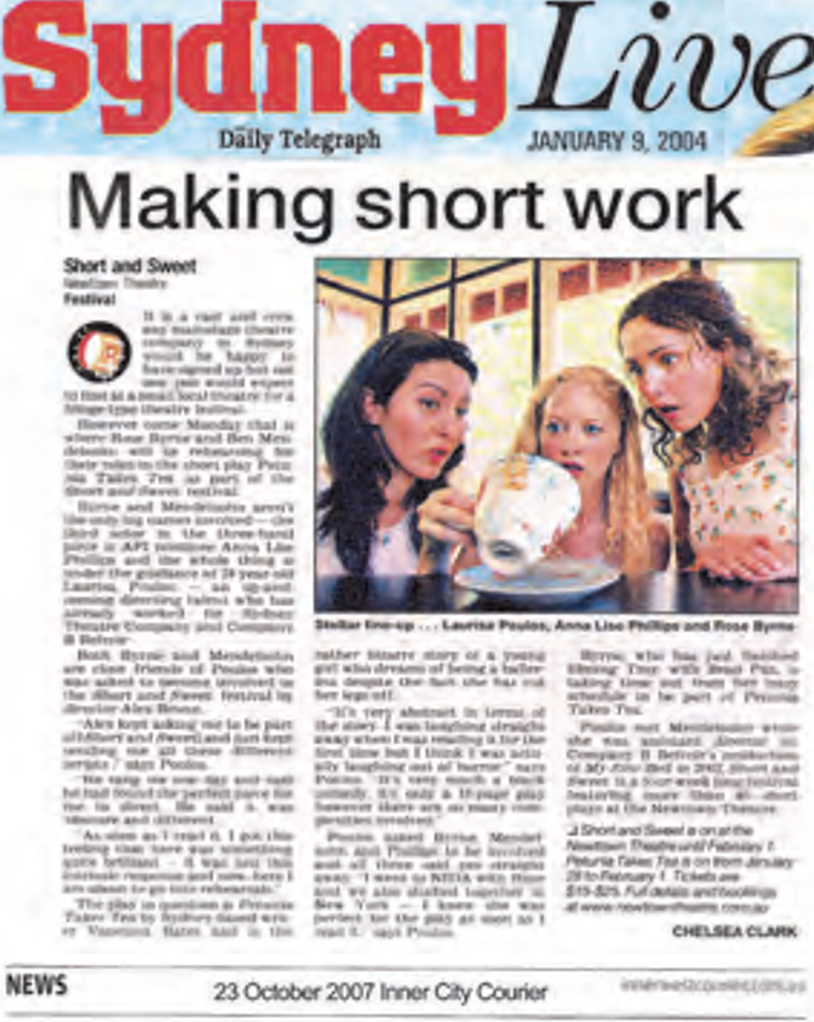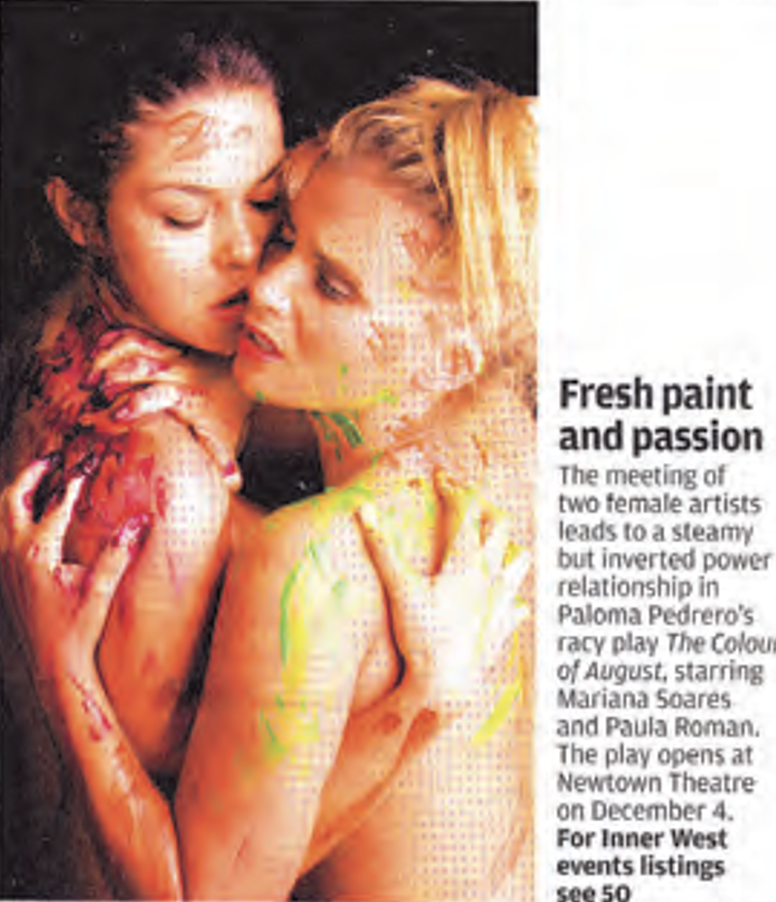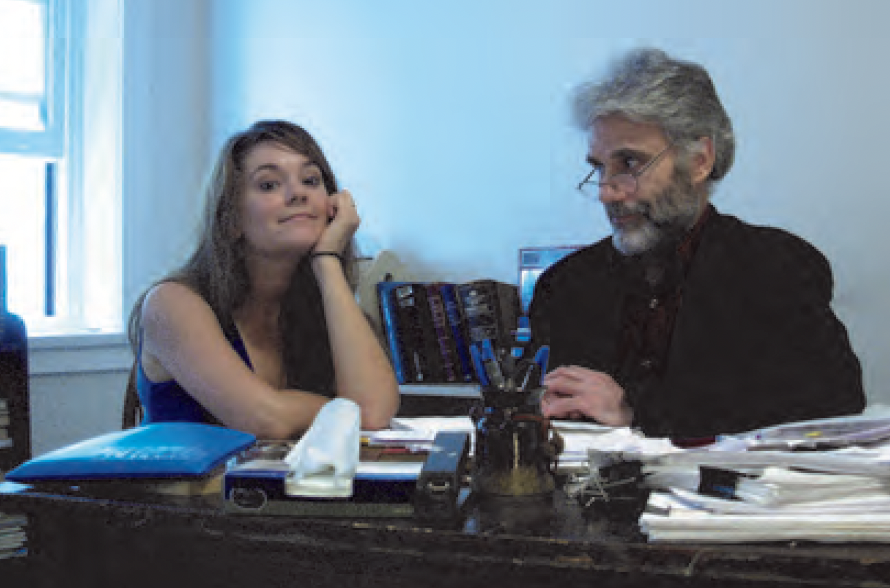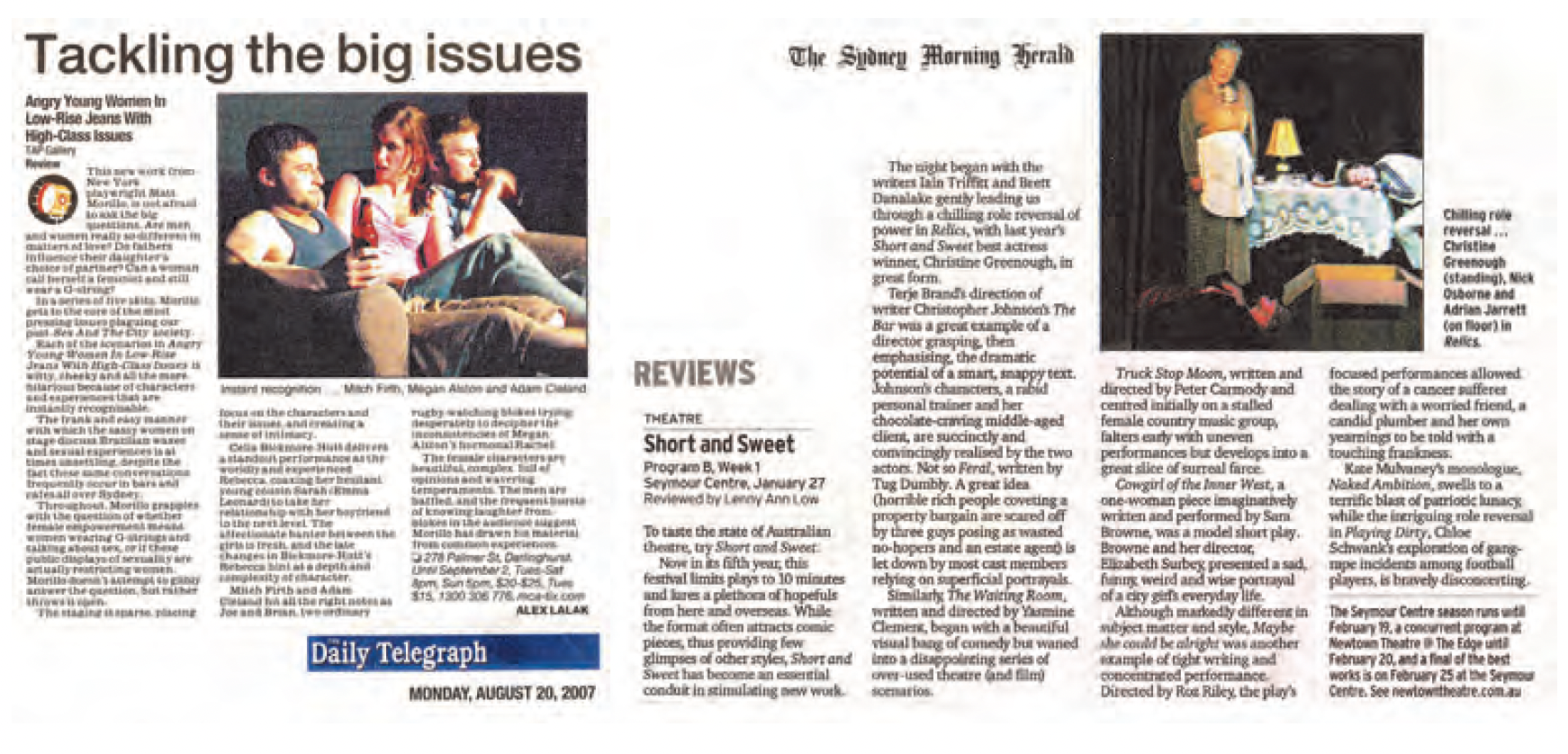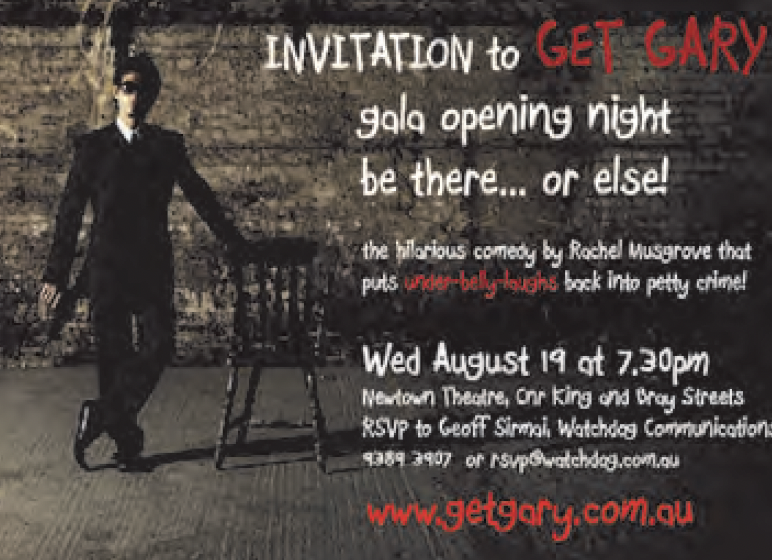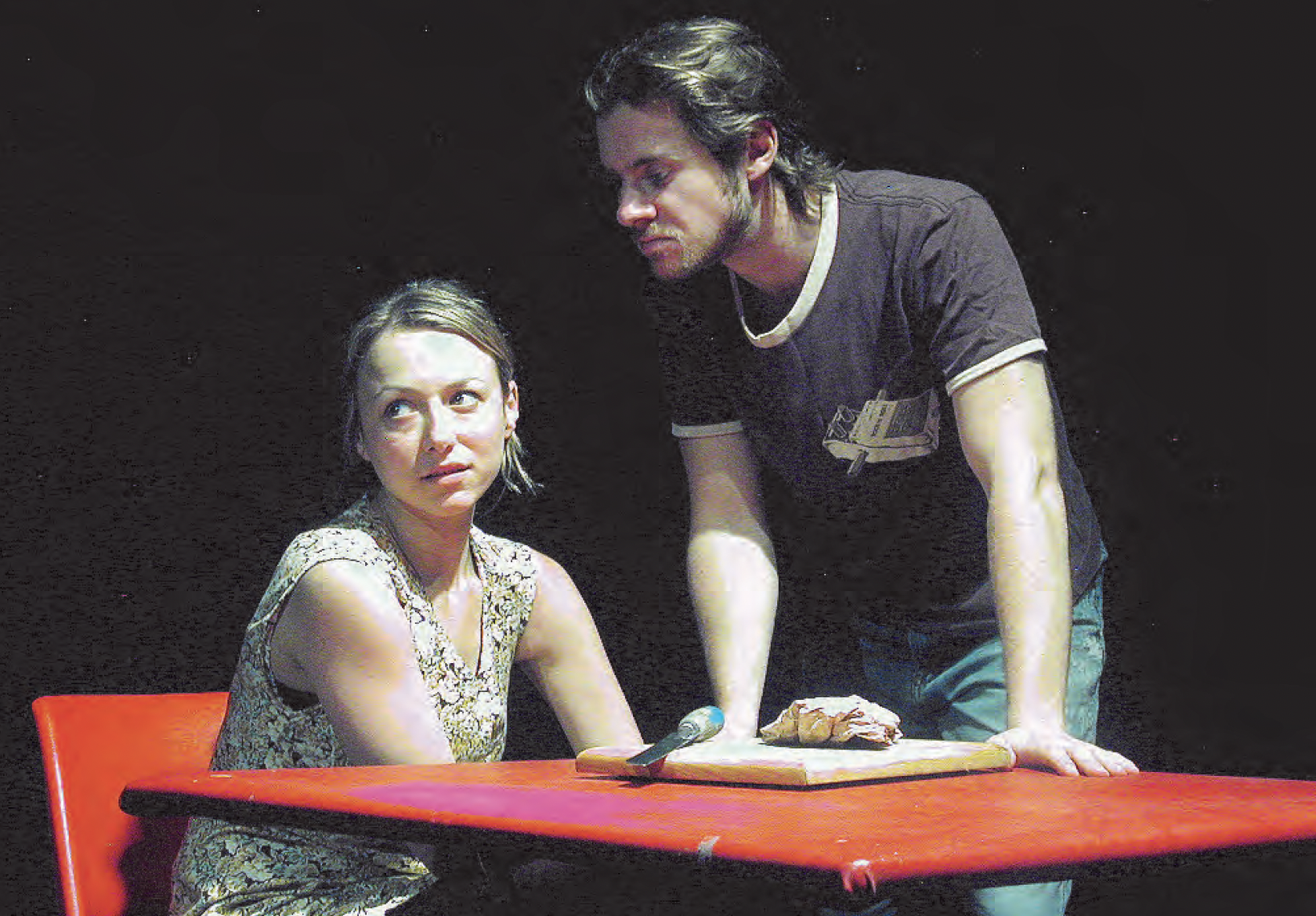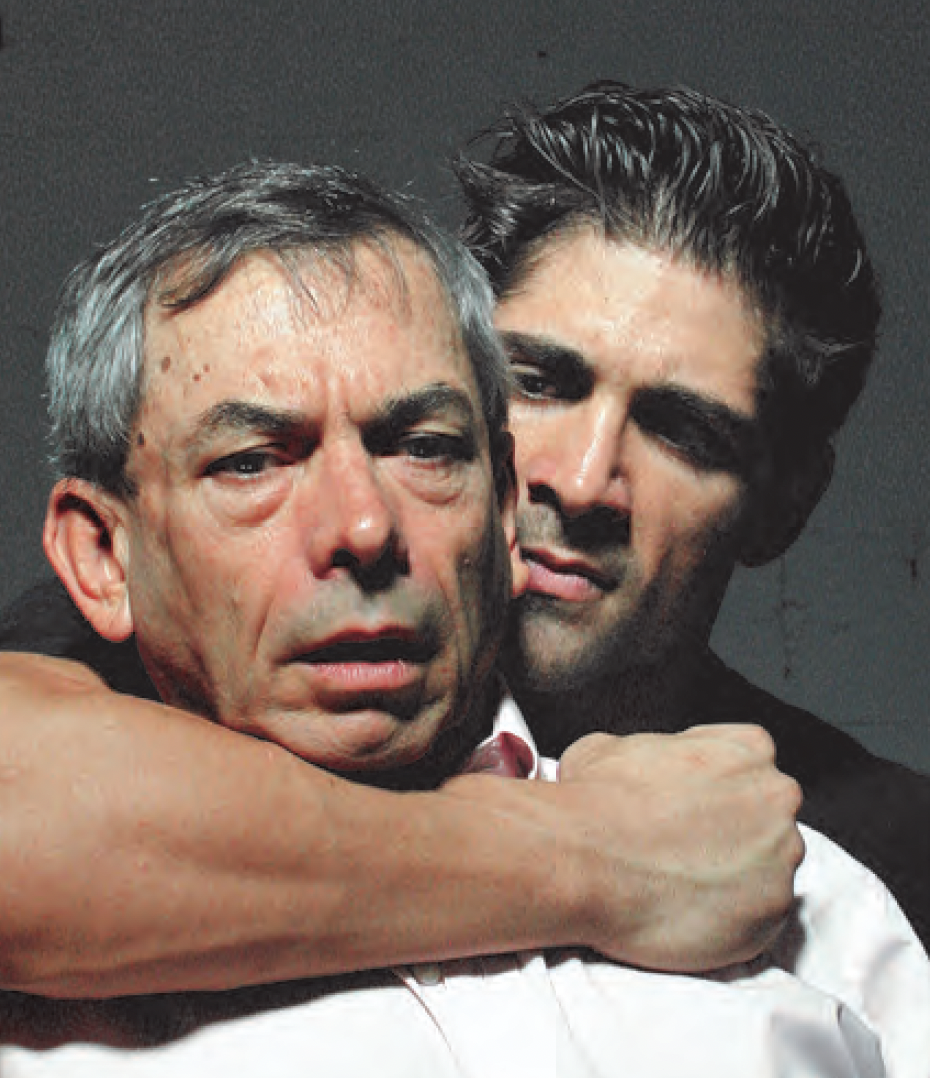
You And Your Publicist
A user's guide to Arts PR and promotion
Preface
This came about in response to two contrasting spurs. The first was an increase in requests from producers for suggestions of ways in which they could help me to help them. Brilliant! This is music to a publicist’s ears and I was delighted to oblige.
What started then as a few short dot points soon grew into a longer document and then a series of articles and finally public workshops. Ultimately, it became clear a short publication would be even more useful as a ‘take-home’ resource for producers, directors and actors.
The second spur was my own observation that a publicist is often perceived as a mystery. When someone says they’re a doctor or a solicitor or an actor, a reasonably clear picture of their work springs to mind. But as for a publicist, many people look a little perplexed. “So what is it that you actually do?” is a question I am commonly asked. Over time, my colleagues and I realised that this translated into artists being unsure of what to expect from their publicist.
Publicity is an inexact science where there’s 'many a slip ‘twixt the cup and the lip'. For all the guile and hard work we bring to bear as a team, there are no guarantees that the media - with their own agenda, timeframes and competing interests - will deliver exactly what we want.
And this is all part of the thrill, the challenge and the excitement of bringing a production alive. It’s what stretches the creativity of both publicist and artist to find new ways of tempting the media to bite. Often this means uncovering more depth and layers in their work than even the artist anticipated - the result of which is a production capable of reaching a wider audience. This is precisely the goal of publicity.
My aim here, therefore, is to clarify, explain and demystify the publicity process. I believe this is the key to better informed - and happier - clients. Just as artists work extraordinarily hard to create their work, there is both rhyme and reason to publicity!
I hope this booklet will make for better communication and cooperation between artists and their publicists in pursuit of the common goal: more - and better - publicity, more recognition for artists, who pour their hearts and souls into their work… and more bums on seats!
Enjoy reading it… and break a leg!
Geoff Sirmai
Sirmai Arts MarketingAngry Young Women With High Class Issues in Low Rise Jeans (MX) Short+Sweet (Inner Western Courier) Fast+Fresh Dance (Sydney Morning Herald Metro cover story) Phoenix Theatre Company’s Laramie Project (Northside Courier) Fast+Fresh Dance (WeeklyView cover story) Short+Sweet (The Glebe cover story)
All photos by Sirmai Arts Marketing unless otherwise stated.Why PR?
WTC’s The Full Monty on Channel 10 News | Elana Stone in Places+Spaces (Central Mag) Heard the one about the producer who realised just the day before opening night that he’d forgotten to publicise his play? I have. Turns out he’d looked at the box office figures for the first time and was shocked to find there were hardly any sales. Then he remembered... Ahah!
How do I know this? Because I was the publicist who took his panicky call! There’s always something that can be done to save the situation… but, like the lost traveler who asks for directions a long way from home, I was tempted to say: “Well, I wouldn’t start from here!” Elana Stone in Places+Spaces (Central Mag).
Professional publicity is an essential part of the promotional ‘mix’ in gaining profile for your event… and getting ‘bums on seats’. Just as marketing (advertising, posters, flyers and direct mail etc) is essential to promoting a show, a concert, a play or festival, publicity - which involves, essentially, free editorial - is vital to getting your event known in a crowded arts and media world.
A publicist arranges press articles, radio and TV interviews, 'what’s on' listings in the press and on the internet, reviews and feature articles. The benefits are obvious - especially for companies whose budget will not stretch to expensive advertising.
Press and electronic media coverage also have more weight than ads - they carry the editorial stamp of approval, not just the supposed ‘self-promotion’ of advertising that can more easily be dismissed. ‘Third party’ promotion through a publicity company is also more tasteful than blowing your own trumpet...however tunefully!
Your performers and the rest of your creative team also appreciate coverage which rewards them for their efforts and gains them wider professional recognition. It enhances your company’s reputation and reinforces your ‘brand’. All of which is not easily done without the skills, the contacts, the dedicated time and the experience that a professional publicist offers.
Your publicist may also offer extensive audience and artist databases to boost your campaign with effective direct e-marketing. Again, this kind of ‘below-the-line’ promotion is essentially cost-free. A PR company can also assist with photography, handle your opening night invitations and attract reviewers, casting agents, industry VIPs or celebrities to help you make a ‘splash’.
In the end, audiences will judge your show’s success. But don’t leave a stone unturned to make certain you get as many of them there as you can! Whomever you choose to handle your publicity, don’t forget about it… Remember, putting on a show without PR is like winking at someone cute in the dark: you know what you’re doing… but no one else does!
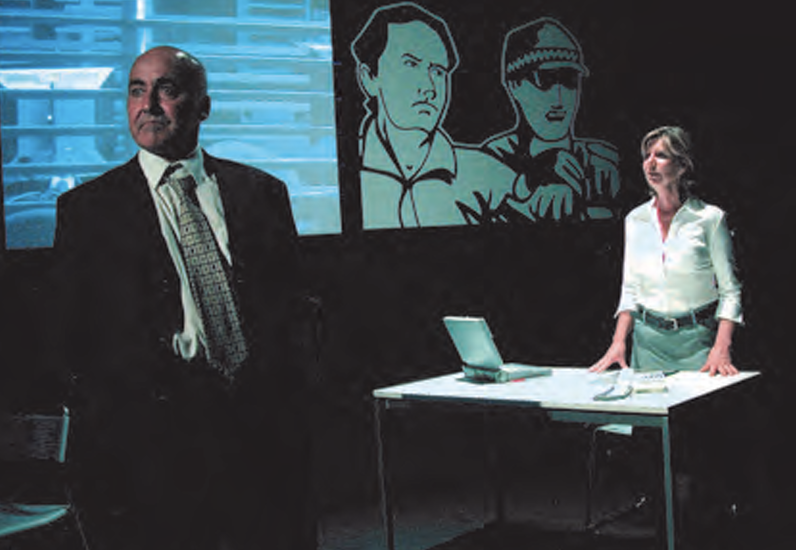
Going It Alone...Good Luck!
Many independent arts producers - and most community theatre groups - try to handle the promotion of their event themselves. Most invariably fall short of being able to commit the necessary attention to the task while handling their other jobs. It’s an area where expertise and contacts make all the difference.
Engaging a professional publicist takes the hard work and guess-work of D-I-Y PR off your hands. That leaves you the time and space to get on with your main business... that's show business!
There’s nothing worse than leaving this important work undone and then finding - all too late - that you’ve dropped the ball. By then, it may be far to late to get the word out - and you’ve not done justice to the efforts of your cast and crew. So, don’t think you can’t afford a publicist… you can’t afford not to have a one!
Production photo from Political Fiction What a Publicist Does
Your publicist is the messenger between your production and the media. He or she takes your briefing information and images or recordings of the show, details about its creators and its artists and seeks to place stories with newspapers, magazines and online media, to arrange interviews and airplay on radio and TV and generally to spread the word through all public (and sometimes private) channels. To do this, they may create media releases, e-flyers, kits and backgrounders, even audio or video samples, to tempt journalists, editors, presenters and producers to run stories about your event. Your publicist is skilled at turning the raw information you provide into the form that will most appeal to the media.
Even so, the quality of the material you give to your publicist - and the timely manner in which you provide it - is crucial to maximising the chances of success.
Promotional photo for Newtown Theatre’s Fencelines What a Publicist Doesn’t Do
Creating and distributing marketing materials like posters, flyers and leaflets is not part of the publicist’s role. Nor is arranging advertising or any other paid promotion; that is a job for the producer since it involves spending production money. The publicist's work - apart from their fee - is essentially cost-free, since it concentrates on free editorial possibilities. However, keeping your publicist informed about any marketing you do is helpful, since they may be able use this to leverage complementary editorial. Your posters and flyers may also make excellent material for adapting into photos or sending out in free e-bulletins and other direct electronic marketing. Even so, the quality of the material you give to your publicist - and the timely manner in which you provide it - is crucial to maximising the chances of success.
What You Need to Provide
Publicity photo for The Bridesmaid Must Die The basic information your publicist will want - at least 6-8 weeks ahead of performance date - includes:
A description of the play, event or production including any background on its history;
Details of the presenting company;
Creative artist, cast and crew details - who has what role, both onstage and backstage;
Contact details - phone and email contacts for each of the cast and crew, including a home suburb, so that local media angles can be pursued;
The poster and/or flyer as a digital file. This can be turned by your publicist into an ‘e-flyer’, a modest sized graphic (normally a jpeg, rather than a pdf file) for sending to the media and for use in direct e-marketing to audience groups; • Photos
Suggestions of good angles or story ideas are always welcome. Do cast and crew members have a special community connection that they are happy for the publicist to pursue - eg religious, ethnic, gay or lesbian etc?
Certain features of a production, concert or festival are always of special interest. For example, new work, Australian or world premieres are extranewsworthy, as is the debut of new or young artists. High profile artists and celebrity involvement is also likely to attract extra media attention.
Knowing just what will ‘hook’ media interest and matching a certain angle or aspect with each particular media outlet is one of the particular skills of a publicist.

Timing
Publicity photo for The Popular MechanicalsEngage your publicist at least two months ahead and aim to have their briefing material ready no later than 6 weeks out from opening night.
It's essential to always allow plenty of time when promoting your event.
Your publicist will be staggering their approaches to different types of media and will need to offer most outlets plenty of notice. For example, while radio producers tend to work 7 days ahead at most, glossy colour magazines may be filled months ahead of publication date. Daily newspapers may still have room in their front news sections less than 24 hours ahead but their gig guides and lift-outs generally have deadlines at least ten days ahead of publication. Websites may be able to list events overnight, but local press editors plan their arts stories often two to four weeks ahead. In any case, long advance notice never hurts so give your publicist the best chance to do their best for you.
Photos
Good photos are a key ingredient in obtaining good publicity. It’s worth spending time, effort and - if necessary - good money to get good pictures!
Good photos add colour to a story and help ‘frame’ your event for the media and your audience. They invariably gain you double the column space and increase your event’s chances of featuring in ‘what’s on’ columns and the like.
There are many different ways in which photos can be used…
What’s On listings
Feature Articles
Personality profiles
Local angles - this could be about an individual or group •
Reviews
Social pages, event and premiere reporting
This means it’s worth taking many different kinds of photos:
Promotional photos
Rehearsal photos
In-character photos
Personality photos
Production photos
Social photos - opening night guest foyer shots
Rehearsal photo from WTC’s A Chorus Line In addition to this, some press will want to take their own photos. If they are prepared to do this, you should jump at the opportunity since this just about guarantees a large feature article (press rarely ‘waste’ photos they have spent time and resources taking). It is always worth the trouble of setting up a photo shoot with key cast in an appropriate setting. Your publicist can advise you of the sort of venue or setting that will be suitable. Again, be open to the preferences of the press… it will be to your advantage to give them what they want! Finally, be aware that few journalists or press photographers are available to attend rehearsals outside of normal business hours.
Black and white ‘headshots’ are rarely of any use to the media. While these may suffice for programs or for casting agents, most press publish in colour and a ‘headshot’ provides no eventspecific character to the story. Good, sharp action shots, production pictures or specially staged promotional photos - especially in costume and with relevent background, set or props - are more likely to gain you coverage. Even a photo of an actor in a previous role is often preferable to a dull, monochrome out-ofcharacter portrait.
Personality photo, playwright Wayne Tunks with the cast of We’ll Always Have Wagga Promotional shots
Production photo from Takeaway Theatre’s Grounds for Marriage | Performance photo Micheline van HautemEditors are looking for ‘as live’ action or at least the appearance of a production shot.
Keep it tight - two or three people max unless it's a very striking big scene
Good bright colour, not black and white. See above.
Avoid flash - gives unnatural look and often causes shadow, especially if the subject is too close to a background wall etc
Avoid busy, ugly backgrounds - such as often is the case in rehearsal rooms! Either shoot in an attractive natural setting, in a set-up stage setting with good lighting or shoot in plain contrasting background that can be later ‘photoshopped’ or edited.
Light and bright - it’s very important to take photos in bright light. Unless you have a professional camera with the ability to really account for low light and fast movement (without which you'll have focus problems), even a quite expensive domestic digital camera won't be able to give sharp pics on low light if there's much movement. Therefore, it’s best to set up a shot in as much light as possible (stage light is fine, but lots of it), get the moment 'frozen' still and shoot.
Make sure the faces are not in shadow - getting faces to look up but 'cheat' with their eyeline might be necessary.
High resolution. 300 dpi is ideal. And at least 15x10 cm. This will normally equate to a file size of 1MB or higher. Your publicist can always make them smaller for press preview or internet screenshots, but can't make them bigger for publication quality.
Most importantly, they should match the feel and tone of your event. If it’s comedy, make them fun and funny. If your show is dramatic, your photos should reflect that with a powerful image. And don’t try and get all your cast in the photo… two or three artists at most - unless a crowd of characters is the point of the show.
Rehearsal Photos
It’s very hard to get a good rehearsal photo without interrupting rehearsals! High end, high speed cameras are best since interesting action photos without costume or set and often in a difficult space are usually tight (ie close-up) not wide shots. As above, light and focus are your biggest challenges.
In-character photos
Shots of an actor in character may work as general promotion or for an article about the actor themselves. These could be posed 'to camera' or shot as per promotional 'action' shots, as if in a moment from the production.
Personality photos
These are natural photos of the actor or other creative artist, usually posed and smiling to camera. These suit a 'profile' story in local or specialised arts media.
Production Photos
Promotional photos are ideal for pre-publicity. However towards opening night (perhaps at a technical or dress rehearsal) you will usually have the opportunity to take some production photos. These are action shots of the play as performed. If necessary, these can be set up separately too. Apart from adding to your promotional resources for pre-publicity, and perhaps giving you some great foyer photos, these are the pictures that reviewers (or their editors) will want to choose from to illustrate their reviews. The key here is verisimilitude, clarity, colour and relevance. Try to feature all your lead characters in different shots to give editors some choice; they will be trying to match a photo or two with the angle of the review.
Social photos
These are opening night guest foyer shots which can gain you extra coverage in the 'social' pages of the press. Try to include VIPs or celebrities of note and perhaps some shots of the cast and crew mingling in the 'afterglow' of a great premiere!
Social photos from Short+Sweet premiere as published in the Sun-Herald 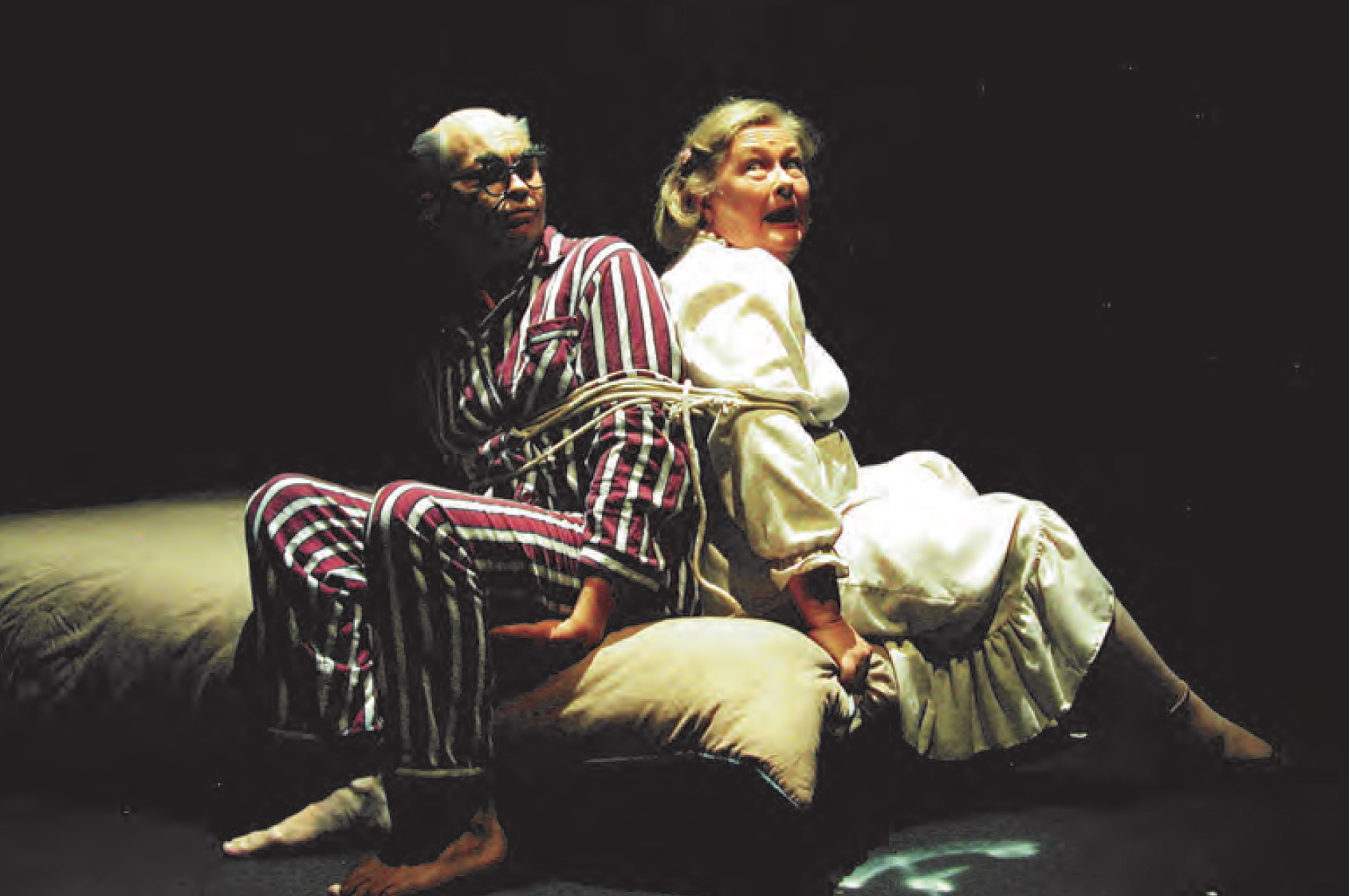
Getting the Best out of Your Publicist
As with most things in the arts - and in life - you get out what you put in! The more and better the information and material you can provide to your publicist, the better equipped they will be to accurately and enthusiastically represent you to the media.
The same applies when it comes time to respond to media interest... treat every interview and photo opportunity as a gift and try to work with your publicist to take advantage of it. Publicity should not be seen as an interruption to your work - although it can sometimes take time out of rehearsals.
Some media can appear demanding - for instance, by giving few 'windows' in which they can send a photographer or interviewer. Perhaps they have certain style restrictions that necessitate a particular place or time for a proposed photo shoot. Try your best to be flexible... the benefit of an original photo and/or exclusive, personal interview is extra column space and once they have committed their own staff's time to a story - almost certainly - guaranteed publication.
The general point is: since you've paid for the benefit of a publicist's expertise... try to take their advice whenever possible!
Production photo from Party PoliticalReporting
Your publicist will keep you informed of what media interest there is and what interviews you need to prepare for, as well as liaising between you and the media to organise interviews and photo shoots. They will also provide a regularly updated media report.
There is no need to contact your publicist every few days for an update. Allow them the time and space to contact all relevant media and to get back to you when they have some news. Of course if you have additional information to forward to your publicist, please do so ASAP. Otherwise, you can expect an update from your publicist every 7 days or so, and possibly more often in the final lead up to your production.
While your publicist will endeavour to track all coverage, scan and send copies of clippings etc, it is not always possible to provide a comprehensive file of articles. Often pieces are published without the journalist or editor coming back to the publicist. This is especially the case with web-based arts sites and ‘what’s on’ listings for whom the media release, e-flyer and preview versions of photos supplied by your publicist may well be enough. Even press articles may be published by newspapers or magazines for whom copies are not easily obtainable in hard copy or on-line.
Comprehensive media clipping services (such as “Media Monitors” etc) are available commercially but are very pricey. These are normally only affordable to corporates or government agencies.
It is also not always possible to tell you exactly when a 'promised' piece will be published: Each media outlet makes its own editorial choices. This may affect when - or even if - a planned article is published. Even the journalist who has written the story is often not sure of publication date until it occurs. Your understanding of this is crucial... again, don't shoot the messenger if the piece you were all hoping for doesn't appear. It won’t have been for want of effort.
Seeking reviews - in discussion with you - is one of the publicist's tasks. They invite and liaise with reviewers and their editors and provide them with information and photos to illustrate the reviews.
A few points about reviewers to bear in mind, though: as with all publicity, there is no way to guarantee the attendance of reviewers from major- or even minor - media outlets. The same principles apply as to pre-publicity and promotion: there is much competition for their attention and decisions about what and where a newspaper or other media will review are ultimately up to their editors.
Be aware that the shorter your performance season, the smaller the chance of scoring a review, since editors must ultimately consider the interest of their readers.
Except for very special events of broad significance, they will consider it pointless to publish a review of a show that is already finished, or almost finished, by the time they go to press.
Nor is there any way to guarantee a positive review!
In any case, be sure when setting the 'media premiere' performance(s) to which you want your publicist to invite reviewers, that you are confident your show will be ready. It is frustrating for a publicist to use all their wiles to tempt along a slew of reviewers, only later to be told by a director they now don't want media attending.
Withdrawing or transferring invitations is professionally embarrassing and makes your production look poor, no matter how diplomatically handled. No publicist wants to read a negative review. But, by the same token, no publicist wants to read a negative review and then be asked by a director "Why did you invite them?" It may be wise to set a 'preview' performance or two to run the show in before opening up to press reviewers. Remember: discuss the who, what and when of review invitations with your publicist in good time!
Reviews
Publicity photo for Educating RitaReviews are an important part of the production and promotion process. Every artist, every producer - and every publicist - loves a good revue... and fears a bad one! They are as much of interest to you as to your audiences: they’re high-profile feedback after all. It's important to remember, though, that most of your audience will hear about your event from another source, most likely pre-promotion, media coverage and marketing. What is said after opening night may have some effect on consequent word-of-mouth and therefore sales, but may not be definitively helpful or harmful. It all depends!
Certainly good reviews can be used by you and your publicist to drum up more positive coverage.
In the case of single performances or short-run seasons, reviews may have no immediate effect at all, perhaps only serving to be useful for quoting in future promotions for future events. Similarly, a poor review - especially one in isolation - need not be seen as disastrous. More on this below under 'bad news and damage control'.
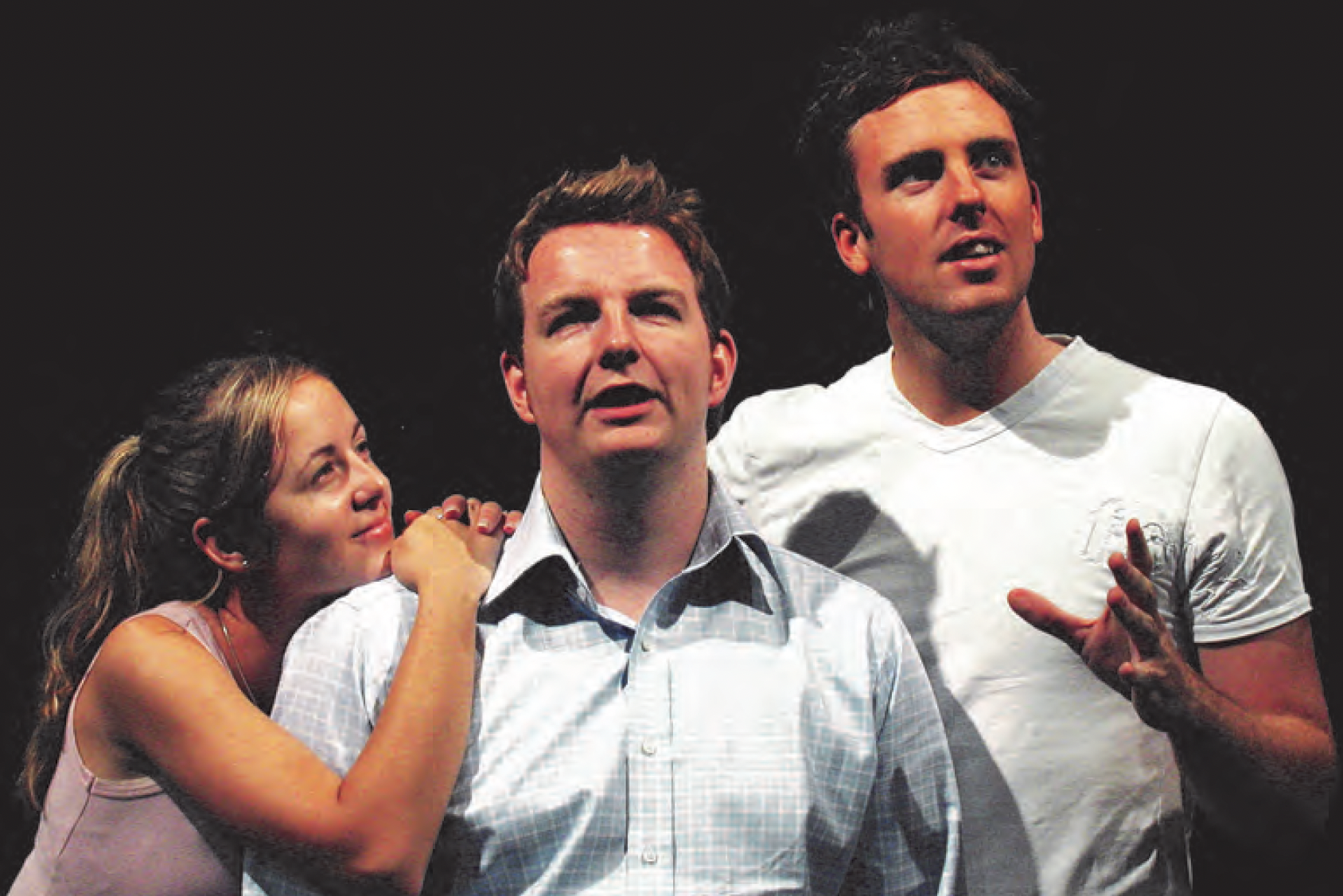
Opening Night - Making a Splash
Apart from media reviewers, opening night is a chance to make a splash with industry VIPs, friends, fans and family. The more supportive the audience on the night, the better the response will be - which may well rub off on any reviewers present! The addition of a celebratory supper - even some modest drinks and snacks - can add immeasurably to the occasion. At any rate, nothing succeeds like success and you should work to ensure a full and enthusiastic house for as many of the first few performances as you can. This can really boost word-of-mouth, therefore any promotions you can do to this end are worth considering.
Discounted tickets, two for one offers - even 'papering' the house with a judicious number of complimentary ticket-holders - can be worth the cost if the crowd leave as vocal and positive advocates for your show. Talk to your publicist about how many tickets you are prepared to give away or discount for this purpose. These can be offered in a variety of ways: as free tickets for listeners with radio interviews; in on-line promotions; or in 'competitions' to specific databases. Properly handled, the public need not know how many seats are actually 'freebies' and therefore the perceived value of your tickets should not be affected. A few huge opening performances will set you up for a successful run. Conversely, nothing casts a pall of gloom over a production (and your cast and crew) more than an opening night performing to a tiny audience. Don't let it happen!
Publicity photo for Tick Tick Boom!Invitations, VIPs, Industry and ‘Celebrities’
Your publicist will handle media invitations and receive their RSVPs, handing over a complete list ahead of opening night. It is normal practice to make these invitations for two people - the invitee 'and guest'.
You may ask your publicist to also invite specific industry personalities, casting agents etc. You should provide contacts for these or discuss what your publicist's various contact lists may already cover.
Again, 'celebrity' guests can help make a splash, especially for the purpose of social press photos (see above). Your publicist can also invite specialist social columnists such as from the Sunday papers; the more 'big names' you can confirm will be present, the greater the chance the press will cover the event.
Marketing, Advertising and ‘Above-the-line’
Paid advertising is the only way to guarantee placement in the media - but it comes with a cost! As mentioned above, your publicist does not arrange advertising, which can vary from cheapish (on arts websites and in local and street press) to hellishly expensive (in metropolitan mainstream press or on TV. However, there are affordable variations within that spectrum, including radio advertising, press event listings and special 'distress' advertising (odd discounted advert spots that may need filling at the last minute). Likewise mail-outs, purchased marketing lists, poster runs etc can complement your other promotional efforts. Discuss this with your publicist if you need to be pointed in the right direction.
Contacts
Your publicist's contacts are their valuable possession, gleaned over years by dedicated attention to the task and maintained by constant communication and painstaking updates.
Please don't ask your publicist to hand them over as they are unable to do so for matters of intellectual and professional property.
Likewise, the preferred method of communication for each of these hundreds of contacts is something your publicist will have well in hand. It is counter-productive to double up and bombard the media with material yourself; it can confuse the media and create an unprofessional image for your production. On the other hand, if you have special media contacts worth following up, don't hesitate either to give your publicist the tip or to make direct contact after discussing it together. Most PR people are not at all precious on this score: it's all hands to the wheel in promoting your event. What is important, though, is the clarity and elegance of the approach - so make sure you have your story straight and use the same agreed material.
In character publicity photo for The Prince of Brunswick EastBad News and Damage Control
There’s an old saying that “Any publicity is good publicity.”
But when is bad publicity actually harmful to a show? Can you turn bad news to your advantage? What about bad reviews… are they fatal?
The short answers are sometimes, usually and not necessarily… in that order. Which adds up to good news for arts producers. Working with your publicist and keeping them informed is vital; they will know how and when to get positive word out… or how best to move on from a setback.
For instance, if you do have to cancel a performance, always make arrangements for audiences that have pre-booked and those that walk-up.
If it’s possible to call them, do so. If you can be there in person to greet and explain at the theatre box office, do so. Polite, apologetic signage in the theatre is a minimum and should always give a contact for more information. It’s not just courtesy, it is also your legal obligation!
If the problem is continuing, you may need to make a public explanation; it’s best to do this before the media (or put-out punters) come knocking!
Controversy can even be turned to your own advantage. One play I was promoting featured so much kissing that it had to be postponed when the lead actor developed coldsores! With his permission and a little discreet placement of stories in gossip columns, the lighter side of the story won a lot of sympathetic and good-humoured coverage.
Publicity photo for BelowAs with any crisis management, much depends on how you break the news. A scandal is no fun, especially when you find yourself in the middle of a media feeding frenzy (yes, start counting cliches now!). It’s important to remain focused on the positives and be clear and honest about what is being done to rectify the situation. If you must refund ticket money, do it with good grace and maybe even throw in a little bonus (such as a discount on future tickets) for goodwill. Audiences appreciate having their expectations surpassed - especially after the disappointment of having them lowered first!
What about bad reviews? Well the truth is that they’re not fatal - especially if they’re not uniformly negative. Audience members often like to compare their own view with the critics’ - who, after all, represent only one opinion. Focus on the good reviews, look for positives, and remember: good word-of-mouth and positive pre-publicity is much more persuasive.
In the end though, the quality of the performance is the biggest factor in predicting success. Beyond the smoke and mirrors, the arts are just like any other type of goods that consumers purchase. They’re not mugs, so treat them with respect.
Produce a great product - and promote it effectively - and the public will beat a path to your door. Offer a lemon and no amount of sweetening will mask the sour taste!
Publicity photo for The Critic
THE PR TOP 10
1. Start early - give yourself and your publicist time to place the stories.
2. Vary your approach to suit the medium - one style doesn’t fit all. Match the ‘angle’ with the outlet - is it a local paper, radio, ethnic or arts specialist? Give your publicist ideas and angles.
3. Make your release newsworthy - Try and ‘hang’ your release on a hot current issue or feature interest beyond the play’s obvious theme. Remember: what you think is interesting may not be so to every journalist. It’s a competition for space! When you have something new to report, tell your publicist!
4. Great photos - quality promotional and production shots will double your coverage. Not cheesy posed shots, but dramatic, powerful or funny ‘moments’. High resolution (300dpi) for the press + low res web versions (72dpi).
5. Don’t over-hype - passion and ingenuity + originality, yes… absurd hyperbole, no. No-one likes a rip-off.
6. Invite opening night guests and the press - make a buzz, make a splash.
7. Give away tickets judiciously - Don’t look desperate but do give away a few ‘comps’ (say on radio or through on-line competitions) in exchange for coverage.
8. Don’t be afraid to invite reviewers - but be ready on opening night if you do!
9. Cross-promote - do complementary offers to another company’s audience in exchange for access to theirs. Negotiate mutual leaflet drops. Remember: a theatregoer at any other show (but especially at the same venue) is your best target audience. Likewise performers are themselves keen consumers of the arts.
10. Measure your success - do you poll your audiences? It’s worth slipping a short survey in the program to see how they found out about the show. Offer an inducement to maximise returns - a prize, a discount voucher etc.
Rhyme or Reason?
It’s easy, especially when absorbed in the passion of your creative work, to develop very high expectations. Your publicist will share your optimism and will be trying for every possible bit of coverage. However, the media make their own decisions about what they will publish or broadcast and no amount of hassling of them - or your publicist! - will change that.
Whether the media publish/broadcast can depend on many factors including:
the timing of your event;
competition from other events;
lack of interest in the story/gig;
lack of space through lack of advertising revenue; and many other things - all beyond our combined control.
Your publicist will do everything possible short of actually stalking them!
They will offer, convince, angle, negotiate. Remember, you are paying for your publicist’s experience and skill in doing this, not for the articles themselves. The only way to guarantee placement is to pay for advertising space.
Be savvy by not putting all your eggs in one basket - and be realistic. Successful media coverage - and/or target audience marketing - is no guarantee of box office results. Audience take-up is a complex - often unpredictable - thing; major factors include: the producers’ advertising and marketing; media publicity coverage; the quality of the show and attendant ‘word of mouth’. Other external factors - entirely beyond all our control - can also affect audience numbers.
Publicity photo for Beginner at LifeYour publicist is in a good position to advise whether an additional approach from the producer will be useful or counterproductive. "Good Cop / Bad Cop" might work in TV crime shows but can be a dangerous thing to attempt with the media.
Sometimes a reasonable complaint, a special request or even a demand is worth making... politely. But be careful before you jump in boots and all!
Good Cop / Bad Cop
Measuring Publicity Success
In measuring the success of your publicity campaign, consider not only the number of articles, but also the quality and reach of articles. For instance, your coverage may include anything from small but prominent listings to large features in local press, high circulation daily metropolitan press, high traffic arts websites and community radio stations with regular but smaller listenerships, right up to ABC or commercial radio talk and music stations with high profile. TV coverage (extremely competitive and with limited outlets) may also give huge reach.
With regard to all your promotions, including marketing not just publicity, regularly polling your audience with short but specific survey questions is a great way to find out which of your strategies has been most successful. “How did you hear about this production?” is worth asking along with other questions designed to gauge audience interest and response.
Curtain Call
And so, to work. And play! Preferably both at the same time…
I hope this booklet has added to your knowledge of the promotional process. Enjoy the great adventure of your production with the reassurance that your publicist is a valuable and enthusiastic member of your team. Don’t hesitate to contact them; working together, as in all creative pursuits, will certainly yield the best results.
Cheers…. and ‘chookas’!
Geoff Sirmai


